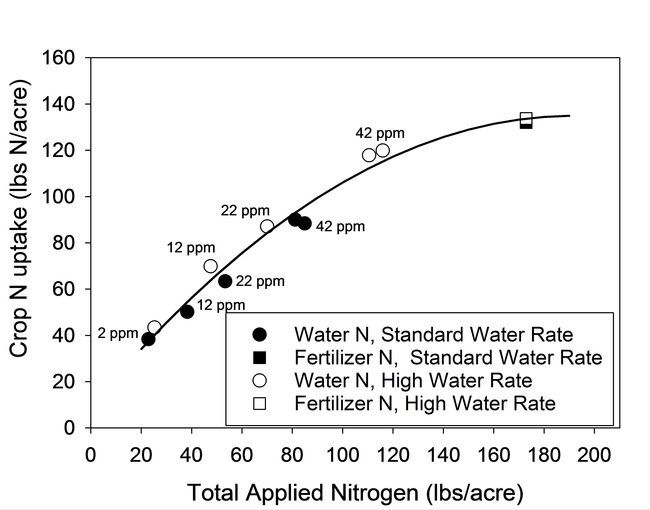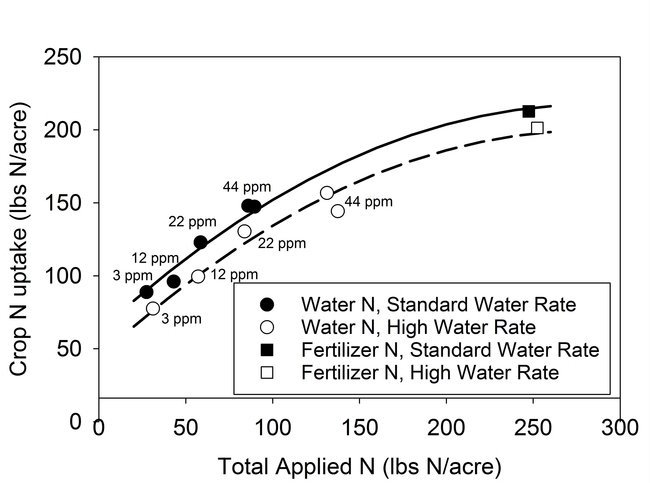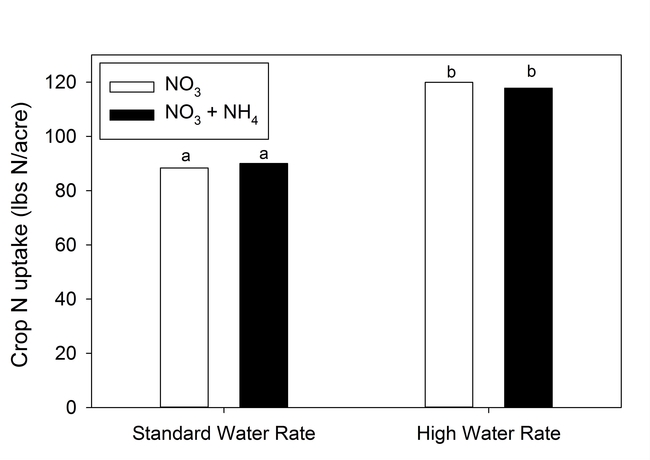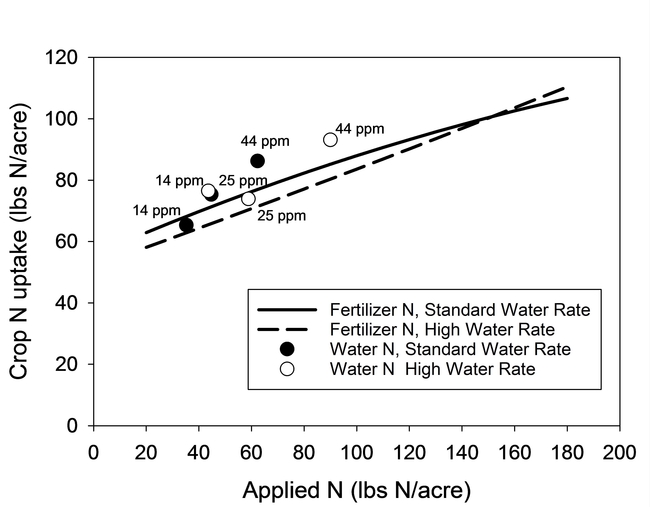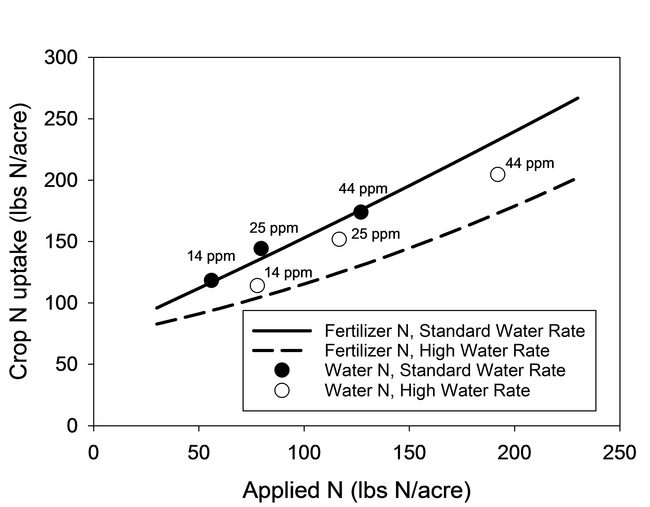Irrigation water from many wells on the central coast contains a significant amount of nitrate-nitrogen (NO3-N); recycled water from the Monterey Regional Water Pollution Control Agency, the sole water source for approximately 12,000 acres of prime Monterey County farmland, is high in both NO3-N and NH4-N. Growers historically have been reluctant to modify their N fertilization practices on the basis of irrigation water N content because it is unclear how one can reliably calculate the ‘fertilizer value' of this N. This issue has taken on added significance with under the current ‘Ag Order' that was adopted by the Central Coast Region Water Quality Control Board in 2012. The Ag Order requires tier 2 and 3 growers who produce vegetable and berry crops to report the total amount of nitrogen applied to crop land, including N contained in irrigation water. Baseline numbers from the first two years of reporting on the Central Coast clearly showed that a majority of vegetable producers applied significantly more nitrogen than their crops took up.
Water quality regulators would like growers to take proactive steps to reduce nitrogen inputs to their crops. One way many growers could make significant reductions in their use of fertilizer N is by off-setting their nitrogen fertilizer rates by a portion of the N applied through their irrigation water. The term “pump and fertilize” has been used to describe this practice because conceptually a grower is pumping water and using the water as fertilizer for the crop. The benefit for the grower is lower fertilizer costs, and the benefit for the environment is reducing nitrate loading to groundwater.
In the Salinas Valley, the nitrate concentration of water pumped from agricultural wells averages more than 20 ppm N. This N concentration would translate to 37 lbs of N per acre for a lettuce crop receiving 8 inches of irrigation water. A significant number of wells have nitrate-N concentrations in the range of 30 to 50 ppm, and the amount of N that potentially could be applied to crops by irrigating with this water could be as high as 55 to 90 lbs per acre. Since most lettuce crops take up 130 to 150 lbs of N per acre, high nitrate water could substitute for one third to half of the fertilizer N normally needed to produce a crop.
Despite the potential benefits of implementing “pump and fertilize,” adoption by growers has been slow. One reason is due to doubts that the nitrate in irrigation water is completely available to crops. Chemically speaking, nitrate in fertilizer and ground water are exactly the same. Nevertheless, growers are concerned that N concentrations in high nitrate water may still be too low to be absorbed by crop roots. Fertilizer N applications usually boosts the N concentration of the water in soil pores to levels much higher than are found in irrigation water.
Another reason that growers are reluctant to account for the N in irrigation water is because they are uncertain about how much fertilizer credit to take when water is applied to leach salts that build up in the soil. Some growers have also expressed concern that the nitrates significantly increase the salinity of water, making it less beneficial to their crops. Finally, growers who use multiple wells to irrigate their fields have difficulty estimating the average N concentration of the irrigation water applied to their crops.
Research trials
Unfortunately, a limited body of research documents the efficiency of crop uptake of N from irrigation water upon which to base an estimate of ‘fertilizer value' under normal irrigation and N management practices. During the past 3 years we conducted replicated field trials to evaluate how much of the nitrate in irrigation water could be taken up by head lettuce (cv. Telluride) and broccoli (cv. Patron). Crops were seeded in two rows on 40-inch wide beds, and germinated with sprinklers. The only N applied at planting was from an anti-crustant application ranging from 17 to 22 lbs N/acre. Crops were drip irrigated after establishment using water of nitrate concentrations ranging from 2 to 44 ppm N. Water-powered injection pumps were used to enrich all drip applied water to target nitrate concentrations. Injected NO3-N was a blend of Ca(NO3)2 and NaNO3 to maintain the cation balance in the water. These water treatments were compared to an unfertilized control and standard fertilizer treatment (150 and 225 lbs N/acre AN20 for lettuce and broccoli, respectively). In addition, a water treatment dominated by NH4-N was included in the trials to simulate the N composition of recycled water. To observe the interaction of irrigation efficiency and crop nitrogen recovery, each N treatment was evaluated at two rates of applied water: 1. Standard water rate of 110% of crop ET 2. High water rate of 160% to 180% of crop ET, which corresponded to a 40% to 50% leaching fraction.
A second set of field trials directly compared crop N recovery from irrigation water and fertilizer. Irrigation water with concentrations of 14, 25, and 44 ppm NO3-N were compared with fertigation applications of AN20 of seasonal totals equal to 0, 20, 60, and 150 lbs N/acre in lettuce and 0, 40, 80, and 200 lbs N/acre for broccoli.
Treatments in all trials were replicated 4 times and individual plots measured 4 beds × 40 ft. All trials were harvested when the highest fertilizer treatment reached commercial maturity. Above ground fresh and dry biomass yield were evaluated in the center two beds of the plots. Whole plant N content was determined so that crop N uptake could be estimated. Crop N uptake was plotted against N applied in the water and fertilizer N treatments. The amount of N applied in the water treatments was calculated by the equation:
Applied N (lbs/acre) = applied water (inches) × NO3 concentration of water (ppm N) × 0.23
Note, that based on this equation applied N from the water treatments will increase as the amount of water applied and concentration of NO3 in the water increases.
Crop N uptake response to nitrate in water
Results of the lettuce trial demonstrated that the concentration of nitrogen in the irrigation water significantly affected plant size, N content of tissue, biomass yield (data not presented) and confirmed that a significant portion of the N in the irrigation water was taken up by the crop (Fig. 1). The crop was able to utilize concentrations of NO3-N as low as 12 ppm in the irrigation water. Similar results were also observed in the broccoli trial (Fig. 2). As shown by the regression curves fit to the data, crop N uptake from irrigation water increased as the concentration of N in water increased. The fertilizer treatment (square symbols) indicated that crop N uptake would likely level off at high N concentrations.
The N uptake from the water treatments in lettuce was similar for high and standard water rates, indicating that the volume of water applied did not affect the recovery of N (Fig. 1) and that all of the applied water could be credited as having N value for the crop. For broccoli, N uptake was lower under the high water rate (180% ET) than the standard water rate (110% ET). However, the recovery of N from the standard fertilizer treatment was also less under the high water rate (Fig. 2).
Figure 1. N uptake by lettuce from water and fertilizer sources of N at standard (110% ET) and high water rates (160% ET). Symbols represent the mean N uptake of water and fertilizer treatments. N concentration of water treatments is displayed next to the symbols
Figure 2. N uptake by broccoli from water and fertilizer sources of N at standard (110% ET) and high water rates (180% ET). Symbols represent the mean N uptake of water and fertilizer treatments. N concentration of water treatments is displayed next to the symbols.
Nitrate and ammonium sources of N in water
The source of N in the irrigation water (NH4 vs NO3) had no significant effect on N recovery by the crop (Fig. 3). Presumably under normal summer temperatures NH4 would quickly transform to NO3 when added to the soil. Nitrate did boost the salinity of water, but the amount was small: approximately 0.07 dS/m for each 10 ppm increase in Nitrate-N concentration. Hence, water with a 45 ppm NO3-N concentration would have a small boost in electrical conductivity equal to 0.31 dS/m.
Figure 3. N uptake by lettuce from water with nitrate and ammonium sources of N at standard (110% ET) and high water rates (160% ET).
Crop recovery of N from water vs fertilizer
The second set of trials confirmed that crop recovery of N from irrigation water and fertilizer was similar in lettuce (Fig. 4) and in broccoli (Fig. 5). Symbols in both figures represent the mean N uptake response from the water treatments, and the regression curves were fit to the N uptake response to the fertilizer treatments. The observation that crop N uptake of most water treatments was equal to or greater than values represented by the regression line demonstrated that crop recovery of N from irrigation water was equal to or greater than from fertilizer. Similar to the previous trials, crops were able to recover N from water with concentrations of nitrate as low as 14 ppm N. N recovery was similar under high and standard water rates for lettuce but as found in the earlier trial with broccoli, crop N recovery declined for both the fertilizer and the water sources of N under the high water rate (Fig. 5).
Figure 4. N uptake by lettuce from water and fertilizer sources of N at standard (110% ET) and high water rates (170% ET). Regression lines represent N uptake response to fertilizer treatments. Symbols represent average N uptake from water treatments. N concentration of water treatments is displayed next to the symbols.
Figure 5. N uptake by broccoli from water and fertilizer sources of N at standard (110% ET) and high water (180% ET) rates. Regression lines represent N uptake response to fertilizer treatments. Symbols represent average N uptake from water treatments. N concentration of water treatments is displayed next to the symbols.
Implications for reducing N inputs
The results of these field trials demonstrated that N in irrigation water has fertilizer value for both shallow (lettuce) and deep (broccoli) rooted vegetables, even when the N concentration in the water was low (12 to 14 ppm N). The trials also showed that the volume of water applied did not affect the crop recovery rate of N from water more than from fertilizer, suggesting that it is reasonable to credit all the N applied in water as having fertilizer value to the crop. These results were attained under well-managed drip irrigation with a high application uniformity and frequent irrigations so that irrigation volumes were small, which likely minimized leaching losses of any single irrigation event. It is possible that under poor water management or less efficient irrigation methods (eg. furrow), recovery of N would be less than was reported in these trials.
Although the results of these experimental trials confirmed that growers can confidently take credit for background levels of nitrate in the irrigation water, one should still be cautious when implementing this practice. Experimenting on fields where the water source is known to have a consistently high concentration of nitrate but is not excessively high in salts is recommended. Drip provides better control of irrigation volumes than sprinklers and furrow systems, which may minimize excessive leaching, and also offer more opportunities for fertigating N to correct observed deficiencies. Because the crop water use is low during the first weeks after planting, it is also reasonable to wait until after establishment to take credit for the nitrogen applied in irrigation water. Soil nitrate levels should be monitored after crop establishment to determine if the soil has a sufficient supply of N. If using multiple water sources for a crop, the nitrate concentration of the blended water needs to be determined in samples collected at the field. Finally, applied water volumes need to be accurately monitored to estimate the amount of N that was applied through the irrigation water.
With water quality regulations continuing to become stricter for agriculture, it makes sense for growers to start implementing practices that can both lower farming costs and are beneficial for the environment. By accounting for the nitrate in irrigation water and using the soil nitrate quick test to monitor soil N levels, growers may be able to make significant progress in reducing the amount of fertilizer nitrogen needed to produce their crops, and demonstrate that they are addressing water quality concerns.
Acknowledgements
We thank Sharon Benzen and David Lara of the USDA-ARS in Salinas, CA for assistance with the field trials. This project was funded by a grant from the California Department of Food and Agriculture's Fertilizer Research and Education Program (FREP) and the Fertilizer Inspection Advisory Board.
